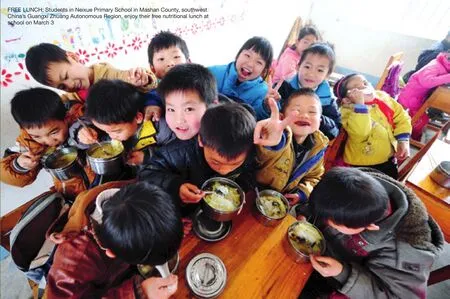Feeding For Growth
2012-10-16ChinapilotswaystoimprovenutritionamongpoorruralstudentsByWangHairong
China pilots ways to improve nutrition among poor rural students By Wang Hairong
Feeding For Growth
China pilots ways to improve nutrition among poor rural students By Wang Hairong
For poor students in boarding schools in Mashan County, southwest China’s Guangxi Zhuang Autonomous Region,March 5 marked a turning point in their lives.The county government announced that from that day on, 24,186 students from poor families in the county’s boarding schools would be entitled to three free meals a day at school.
The provision of free meals is part of efforts to implement a national program to improve the nutrition of rural students in the nine-year compulsory education period. The program was released by the State Council on October 26, 2011.
The State Council decided to pilot the nutrition improvement program in 680 poor counties including Mashan. Under the program, each rural student in elementary and junior middle schools in the pilot areas is entitled to a 3-yuan ($0.47)meal subsidy per day.
The program, with an estimated annual cost of 16 billion yuan ($2.53 billion), is expected to benefit 26 million rural students, or nearly 30 percent of all rural students in central and west China, said the Ministry of Education.
Mashan is situated in a hilly region. In the past, most local schools did not have canteens,and students at boarding schools had to bring a week’s supply of food from home. The majority of students subsisted on a simple diet of steamed rice with soy beans and salt.

NG XIAOBANG
The Mashan County Government decided that from March 5, the nutritional meal subsidy from the Central Government would be used to pay for eligible students’ lunches,whereas the cost of breakfast and supper would be covered by the living allowance that the government has provided to poor rural boarding students in the compulsory education period since 2003.
Better targeted program
In Mashan, the government has worked with NGOs to provide nourishing meals to students since last May. Last year, the county government spent more than 9 million yuan($1.42 million) building canteens for schools,although the county’s total fi scal revenue last year was only 260 million yuan ($41 million).
In Dongqi Primary School in Linwei Town,the spacious and well-lit kitchen was built with 10,000 yuan ($1,580) from public funds.
In addition to government fi scal support,many schools in Mashan have also received assistance from businesses and social organizations.
The kitchen equipment in Dongqi Primary School, including rice steamers, water boilers, soy bean milk makers and a meat mincer,were donated by Joyoung Hope Kitchen Foundation founded by Joyoung Co. Ltd., a major producer of kitchen utensils in China.
Joyoung has donated kitchen utensils worth more than 600,000 yuan ($94,878) to 23 primary and middle schools in Linwei.
“In addition to kitchen utensils, the Dongqi Primary School has received an additional ‘free lunch’ subsidy from the China Social Welfare Foundation, a non-governmental organization,” said Huang Yaxi, the school’s headmaster. The foundation provides 1 yuan ($0.15) per student per day on top of the Central Government’s 3-yuan nutritional meal subsidy to cover the cost of lunch.
After the national nutrition improvement program was launched, the 21st Century Education Research Institute based in Beijing conducted a study on the program’s implementation. On February 28, the institute released a report saying that most schools piloting the program did not have sufficient funds to acquire cooking and dining facilities and pay staff to prepare and serve meals.
So far, the government has not issued clear directives on who should pay for labor and the cost of preparing and serving meals.In Mashan, schools have adopted different strategies to ensure that meals are prepared and served to students.
Some schools such as the Qingtang Primary School in Guzhai Yao Ethnic Township have hired workers to cook and serve meals. In other schools such as the Heli Primary School in Linwei Town, teachers take turns to cook meals although they receive no additional pay. On the Bawu Youyi Campus of Huangfan Primary School in Linwei Town,the school has agreed to let some parents cook meals at home and then bring the food to school and distribute it to students.
Government in action
In recent years, the absolute number of rural students in the compulsory education period has decreased, leading to the closure and merger of many rural schools. Many students now have to travel longer distances to reach schools or go to boarding schools.
Boarding students have three meals in school, and some non-boarding students also need to have lunch at school, so whether children can have enough warm food to eat at school is a major concern for every family and the whole society.
Although children’s nutritional condition in central and west China has improved in recent years, a number of issues have still not been addressed.
On February 27, 2011, the China Development Research Foundation released a study on the nutritional condition of poor rural students in China.
It revealed that the nutrition intake for children in poor areas in central and west China was far from sufficient. Scholars call this phenomenon “nutritional poverty.”
Researchers found that 12 percent of the surveyed students suffered from growth retardation, and 9 percent were under weight.
Many non-boarding students from poor families were also found suffering malnutrition and growth retardation. Previously fi scal support was only given to poor rural boarding students, whereas poor non-boarding students were not eligible.
In 2003, the Central Government decided to give poor rural boarding students a living allowance.
But the study by the China Development Research Foundation concluded that because the Central Government did not specify that the living allowance was to be used to improve students’ diets, various local government departments disagreed as to how to use the subsidy and how to improve students’ nutrition levels. For instance, the Finance Department of Guangxi stipulated that the subsidy should be granted to parents in cash. But parents often used this money for other purposes than improving their children’s nutrition.
In response, the State Council said in a statement last October that the living allowance for poor rural boarding students should be strictly used to provide food for them.
In January, ministries of fi nance and education announced they would invest an additional 10 billion yuan ($1.6 billion) to build kitchens for schools covered by the national nutrition improvement program. They have also unveiled multiple accountability systems to ensure the fund are used for the intended purpose.
The Ministry of Education has encouraged participation of charity organizations and individuals in implementing the national nutrition improvement program.
“While the government plays a leading role, it takes a joint social effort to improve the nutritional condition of poor rural students. The Central Government’s fiscal support will not“crowd out” the efforts of local governments, social organizations and individuals in this regard,”said theChinese Education News.
